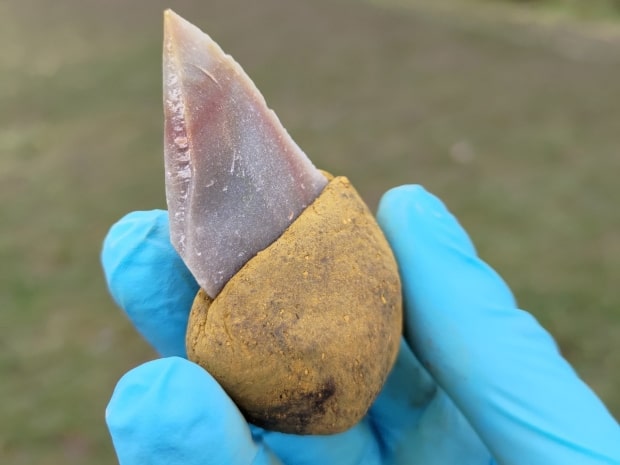- Joined
- Jul 13, 2009
- Messages
- 20,580
Neanderthals used glue to make stone tools 40,000 years ago, a new study suggests “Earliest evidence of a multi-component adhesive in Europe”

Cover Photo: An artist’s reconstruction shows how a Neanderthal could hold a stone artifact with an adhesive handle. Daniela Greiner
More than 40,000 years ago, Neanderthals in what is now France used a multi-component adhesive to make handles for stone tools. They produced a sophisticated mixture of ochre and bitumen, two raw materials that had to be procured from the wider region. This is the earliest discovery of a multi-component adhesive in Europe to date.
This complex adhesive found on Neanderthal stone tools has given researchers new insights into the intelligence of this extinct human species.
The work, reported in the journal Science Advances, included researchers from New York University, the University of Tübingen, and the National Museums in Berlin.
Under the direction of Dr. Patrick Schmidt from the University of Tübingen’s Early Prehistory and Quaternary Ecology section and Dr. Ewa Dutkiewicz from the Museum of Prehistory and Early History at the National Museums in Berlin, researchers re-examined finds from the Neanderthal site of Le Moustier in the Dordogne for evidence of prehistoric glues.
The development of adhesives and their use in the manufacture of tools is considered to be some of the best material evidence of the cultural evolution and cognitive abilities of early humans.
“These astonishingly well-preserved tools showcase a technical solution broadly similar to examples of tools made by early modern humans in Africa, but the exact recipe reflects a Neanderthal ‘spin,’ which is the production of grips for handheld tools,” says Radu Iovita, an associate professor at NYU’s Center for the Study of Human Origins.
The stone tools from Le Moustier are kept in the collection of the Museum of Prehistory and Early History and had not previously been examined in detail.

The Swiss archaeologist Otto Hauser recovered them in 1907 from the upper rock shelter at Le Moustier, which was used by Neanderthals during the Middle Palaeolithic period of the Moustérien between 120,000 and 40,000 years ago. They were rediscovered during an internal review of the collection and their scientific value was recognized.
“The items had been individually wrapped and untouched since the 1960s. As a result, the adhering remains of organic substances were very well preserved,” says Ewa Dutkiewicz.
Remains of ochre and bitumen on stone tools
The researchers discovered traces of a mixture of ochre and bitumen on several stone tools, such as scrapers, flakes and blades. Ochre is a naturally occurring earth pigment. Bitumen is a component of asphalt and can be produced from crude oil, but also occurs naturally in the soil. “We were surprised that the ochre content was more than 50 percent. This is because air-dried bitumen can be used unaltered as an adhesive, but loses its adhesive properties when such large proportions of ochre are added,” says Schmidt. He and his team tested this in tensile tests and with experimentally produced reference material.“It was different when we used liquid bitumen, which is not really suitable for gluing. If 55 percent ochre is added, a malleable mass is formed,” he says. It is only just sticky enough for a stone tool to remain stuck in it, but the hands stay clean – so it is a good material for a handle. “A microscopic examination of the use-wear traces on these stone tools, carried out in collaboration with New York University, revealed that the adhesives on the tools from Le Moustier were used in this way,” according to the researchers.
Targeted approach
The use of adhesives with several components, including various sticky substances such as tree resins and ochre, was previously known from early modern humans, Homo sapiens, in Africa but not from European Neanderthals. “Compound adhesives are considered to be among the first expressions of the modern cognitive processes that are still active today,” says Schmidt.In the Le Moustier region, ochre and bitumen had to be collected from distant locations, which meant a great deal of effort, planning and a targeted approach. “Taking into account the overall context of the finds, we assume that this adhesive material was made by Neanderthals,” says Dutkiewicz. “What our study shows is that early Homo sapiens in Africa and Neanderthals in Europe had similar thought patterns,” says Schmidt. “Their adhesive technologies have the same significance for our understanding of human evolution.”
Last edited by a moderator:
